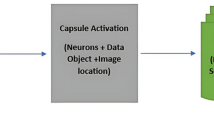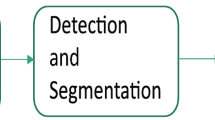Abstract
The epidemic of malaria has caused many deaths for decades around the world. To shorten the morbidity of malaria, accurate and fast diagnostic tools are to be implied with Artificial Intelligence. In this research, an automated, fast, and accurate diagnostic model for one-shot detection and classification of malaria thin blood smears were developed using the Deep Siamese Capsule Network (D-SCN) and contributions for our research are threefold. Firstly, we proposed the D-SCN model which consists of two crucial phases which are feature extraction and feature discrimination. Secondly, we implied an end-to-end trained capsule network with an imperative routing (IR) mechanism for the feature extraction phase to capture feature invariances. Finally, at the feature discrimination phase, Lorentz, L1 and L2 similarity metrics were proposed for the dissimilation of features. During experimentation, it is observed that the Lorentz similarity metric provided more discriminative capability by acquiring the least MSE at most of the instances. Further, an algorithm is proposed to obtain faster convergence by cautiously tuning the hyperparameters, and this aided in decreasing the noise scale in training the D-SCN. The experimental outcomes proved that D-SCN outperformed with the highest detection accuracy of 97.24% for Lorentz as a similarity measure, and the Capsule network with IR mechanism outperformed with the highest classification accuracy of 98.89%. To our knowledge, the proposed research implications are the first applications of D-SCN for one-shot detection and classification of thin blood smears with state-of-the-art performance.








Similar content being viewed by others
References
[Online]. Available: http://ftp://lhcftp.nlm.nih.gov/Open-Access-Datasets/Malaria/cell_images. [Accessed: 21-Aug-2021].
Anggraini D, Nugroho AS, Pratama C, Rozi IE, Iskandar AA, and Hartono RN (2011) “Automated status identification of microscopic images obtained from malaria thin blood smears,” in Proceedings of the 2011 international conference on electrical engineering and informatics
Arco JE, Górriz JM, Ramírez J, Álvarez I, Puntonet CG (2015) Digital image analysis for automatic enumeration of malaria parasites using morphological operations. Expert Syst Appl 42(6):3041–3047
Bertinetto L et al. (2016) Fully-convolutional siamese networks for object tracking." European conference on computer vision. Springer, Cham
Bibin D, Nair MS, Punitha P (2017) Malaria parasite detection from peripheral blood smear images using deep belief networks. IEEE Access 5:9099–9108
Bromley J, Bentz JW, Bottou L, Guyon I, LeCun Y, Moore C, … Shah R (1993) Signature verification using a “Siamese” time-delay neural network. Int J Patt Recogn Artif Intell 7(04):669–688
Chopra S, Hadsell R, and LeCun Y (2005) “Learning a similarity metric discriminatively, with application to face verification,” in 2005 IEEE computer society conference on computer vision and pattern recognition (CVPR’05)
Das DK, Ghosh M, Pal M, Maiti AK, Chakraborty C (2013) Machine learning approach for automated screening of malaria parasite using light microscopic images. Micron 45:97–106
Das DK, Maiti AK, Chakraborty C (2015) Automated system for characterization and classification of malaria-infected stages using light microscopic images of thin blood smears: Characterization and classification of malaria-infected stages. J Microsc 257(3):238–252
Deza MM, Deza E (2009) Encyclopedia of distances. Encyclopedia of distances. Springer, Berlin, Heidelberg, pp 1–583
Díaz G, González FA, Romero E (2009) A semi-automatic method for quantification and classification of erythrocytes infected with malaria parasites in microscopic images. J Biomed Inform 42(2):296–307
Dong Y et al. (2017) “Evaluations of deep convolutional neural networks for automatic identification of malaria-infected cells,” in 2017 IEEE EMBS international conference on Biomedical & Health Informatics (BHI)
G. M. Programme, “World malaria report 2019,” Who.int, 04-Dec-2019. [Online]. Available: https://www.who.int/publications/i/item/9789241565721. [Accessed: 21-Aug-2021].
Girshick R (2015) Fast R-CNN. Proceedings of the IEEE international conference on computer vision
Gopakumar GP, Swetha M, Sai Siva G, Sai Subrahmanyam GRK (2018) Convolutional neural network-based malaria diagnosis from focus stack of blood smear images acquired using custom-built slide scanner. J. Biophotonics 11(3)
He K, Zhang X, Ren S, and Sun J (2016) “Deep residual learning for image recognition,” in 2016 IEEE conference on computer vision and pattern recognition (CVPR)
Huang G, Liu Z, Van Der Maaten L, and Weinberger KQ (2017) “Densely connected convolutional networks,” in 2017 IEEE conference on computer vision and pattern recognition (CVPR)
S. Ioffe and C. Szegedy, “Batch Normalization: Accelerating deep network training by reducing internal covariate shift,” arXiv [cs.LG], 2015.
Janocha K and Czarnecki WM (2017) On loss functions for deep neural networks in classification,” Schedae Inform.. 1/2016
Koch G, Zemel R, Salakhutdinov R (2015) Siamese neural networks for one-shot image recognition. ICML Deep Learn Workshop 2
Krizhevsky A, Sutskever I, Hinton GE (2017) ImageNet classification with deep convolutional neural networks. Commun ACM 60(6):84–90
Kumarasamy SK, Ong SH, and Tan KSW (2010) “Robust contour reconstruction of red blood cells and parasites in the automated identification of the stages of malarial infection,” Mach. Vis. Appl.
LeCun Y, Bengio Y, Hinton G (2015) Deep learning. Nature 521(7553):436–444
Liang Z et al. (2016) “CNN-based image analysis for malaria diagnosis,” in 2016 IEEE international conference on bioinformatics and biomedicine (BIBM)
Litjens G, … Sánchez CI (2017) A survey on deep learning in medical image analysis. Med Image Anal 42:60–88
Lu X, Wang W, Ma C, Shen J, Shao L, and Porikli F (2019) “See more, know more: unsupervised video object segmentation with co-attention Siamese networks,” in 2019 IEEE/CVF conference on computer vision and pattern recognition (CVPR)
Madhu G, … Rohit B (2021) Imperative dynamic routing between capsules network for malaria classification. Comput mater contin 68(1):903–919
Madhu G et al. (2020) Capsule Networks for Malaria Parasite Classification: An Application Oriented Model. 2020 IEEE Int Conf Innov Technol (INOCON). IEEE
Madhu G, et al. (2021) "Imperative dynamic routing between capsules network for malaria classification" .Comput, Mat Continua 68.1
Madhu G, et al. (2021) "Convolutional Siamese networks for one-shot malaria parasite recognition in microscopic images." Demystifying Big Data, Machine Learning, and Deep Learning for Healthcare Analytics. Academic Press. 277–306.
Maity M, Jaiswal A, Gantait K, Chatterjee J, Mukherjee A (2020) Quantification of malaria parasitaemia using trainable semantic segmentation and capsnet. Pattern Recogn Lett 138:88–94
Malihi L, Ansari-Asl K, and Behbahani A (2013) “Malaria parasite detection in giemsa-stained blood cell images,” in 2013 8th Iranian conference on machine vision and image processing (MVIP)
Moon S et al (2013) An image analysis algorithm for malaria parasite stage classification and viability quantification. PLoS One 8(4):e61812
Rajaraman S, … Thoma GR (2018) Pre-trained convolutional neural networks as feature extractors toward improved malaria parasite detection in thin blood smear images. PeerJ 6:e4568
Ren S, He K, Girshick R, Sun J (2017) Faster R-CNN: towards real-time object detection with region proposal networks. IEEE Trans Pattern Anal Mach Intell 39(6):1137–1149
Ronneberger O, Fischer P, and Brox T (2015) “U-net: convolutional networks for biomedical image segmentation,” in Lecture notes in computer science, Cham: Springer International Publishing. 234–241.
Ross NE, Pritchard CJ, Rubin DM, Dusé AG (2006) Automated image processing method for the diagnosis and classification of malaria on thin blood smears. Med Biol Eng Comput 44(5):427–436
Russakovsky O, … Fei-Fei L (2015) ImageNet large scale visual recognition challenge. Int J Comput Vis 115(3):211–252
Sabour S, Frosst N, and Hinton GE (2017) Dynamic routing between capsules. arXiv [cs.CV]
Sayyed AQMS, Saha D, Hossain AR, and Shahnaz C (2019) “Effectiveness of convolutional and capsule network in malaria parasite detection,” in 2019 IEEE International Conference on Signal Processing, Information, Communication & Systems (SPICSCON)
Simonyan K and Zisserman A (2014) “Very deep convolutional networks for large-scale image recognition,” arXiv [cs.CV]
Sio SWS, … Tan KSW (2007) MalariaCount: an image analysis-based program for the accurate determination of parasitemia. J Microbiol Methods 68(1):11–18
Sivaramakrishnan R, Antani S, Jaeger S (2017) Visualizing deep learning activations for improved malaria cell classification. Medical informatics and healthcare, PMLR
Smith KP and Kirby JE (2020) Image analysis and artificial intelligence in infectious disease diagnostics. Clin Microbiol Inf
Smith SL, Kindermans P-J, Ying C, and Le QV (2017) “Don’t decay the learning rate, increase the batch size,” arXiv [cs.LG]
Srivastava N et al (2014) Dropout: a simple way to prevent neural networks from overfitting. The journal of machine learning research 15(1):1929–1958
Swati G Gupta M Yadav M, Sharma, and Vig L (2017) “Siamese Networks for Chromosome Classification,” in 2017 IEEE International Conference on Computer Vision Workshops (ICCVW)
Szegedy C et al. (2015) “Going deeper with convolutions,” in 2015 IEEE conference on computer vision and pattern recognition (CVPR)
Tan M and Le QV (2019) “EfficientNet: Rethinking model scaling for Convolutional Neural Networks,” arXiv [cs.LG]
Tao R, Gavves E, and Smeulders AWM(2016) “Siamese instance search for tracking,” in 2016 IEEE conference on computer vision and pattern recognition (CVPR)
Tek FB, Dempster AG, Kale İ (2010) Parasite detection and identification for automated thin blood film malaria diagnosis. Comput Vis Image Underst 114(1):21–32
Maaten, Laurens van der, and Geoffrey Hinton. "Visualizing data using t-SNE." Journal of machine learning research 9. Nov (2008): 2579–2605.
Varior RR, Haloi M, and Wang G (2016) “Gated Siamese convolutional neural network architecture for human re-identification,” in Computer vision – ECCV 2016, Cham: Springer International Publishing. 791–808.
Wang J, Fang Z, Lang N, Yuan H, Su M-Y, Baldi P (2017) A multi-resolution approach for spinal metastasis detection using deep Siamese neural networks. Comput Biol Med 84:137–146
Zeng X, Chen H, Luo Y, Ye W (2019) Automated diabetic retinopathy detection based on binocular Siamese-like convolutional neural network. IEEE Access 7:30744–30753
Acknowledgments
We thank the JNTUH-TEQIP-III team for providing a grant for the current research with proceedings number: JNTUH/TEQIP-III/2019/CSC/13. We are grateful to the Department of Information Technology, VNRVJIET, for providing extensive support during research.
Availability of data
The data that support the findings of this study are available from the first author upon reasonable request.
Code availability
The code is available from the first author upon reasonable request.
Author information
Authors and Affiliations
Corresponding author
Ethics declarations
Conflicts of interest/competing interests
The authors declare no conflict of interest.
Additional information
Publisher’s note
Springer Nature remains neutral with regard to jurisdictional claims in published maps and institutional affiliations.
Rights and permissions
About this article
Cite this article
Madhu, G., Govardhan, A., Ravi, V. et al. DSCN-net: a deep Siamese capsule neural network model for automatic diagnosis of malaria parasites detection. Multimed Tools Appl 81, 34105–34127 (2022). https://doi.org/10.1007/s11042-022-13008-6
Received:
Revised:
Accepted:
Published:
Issue Date:
DOI: https://doi.org/10.1007/s11042-022-13008-6




